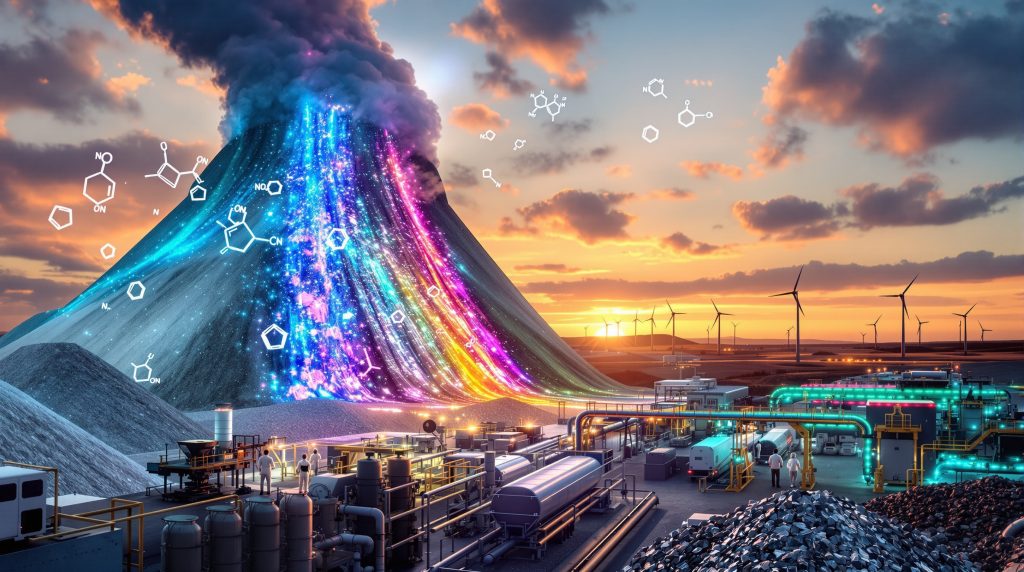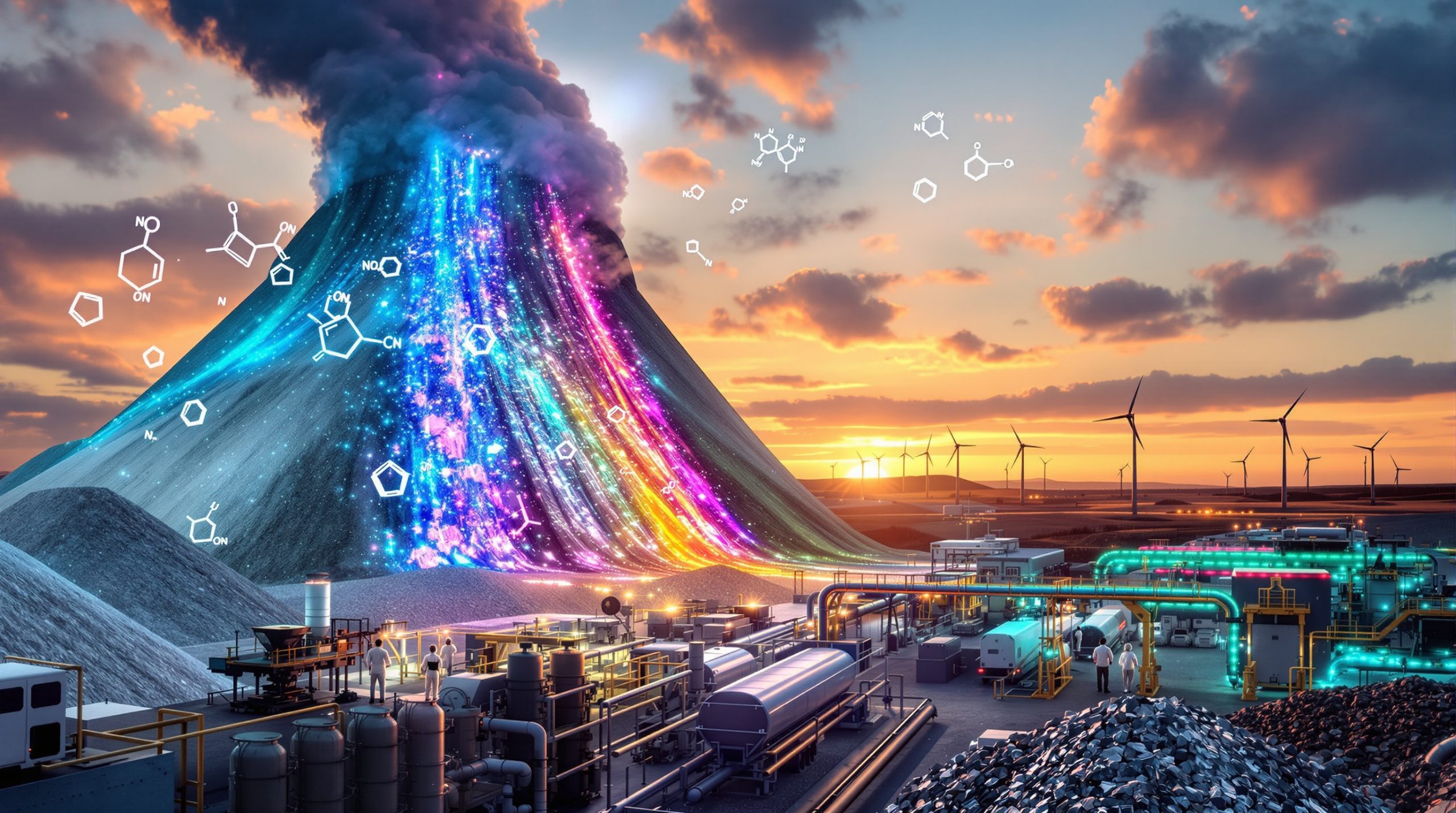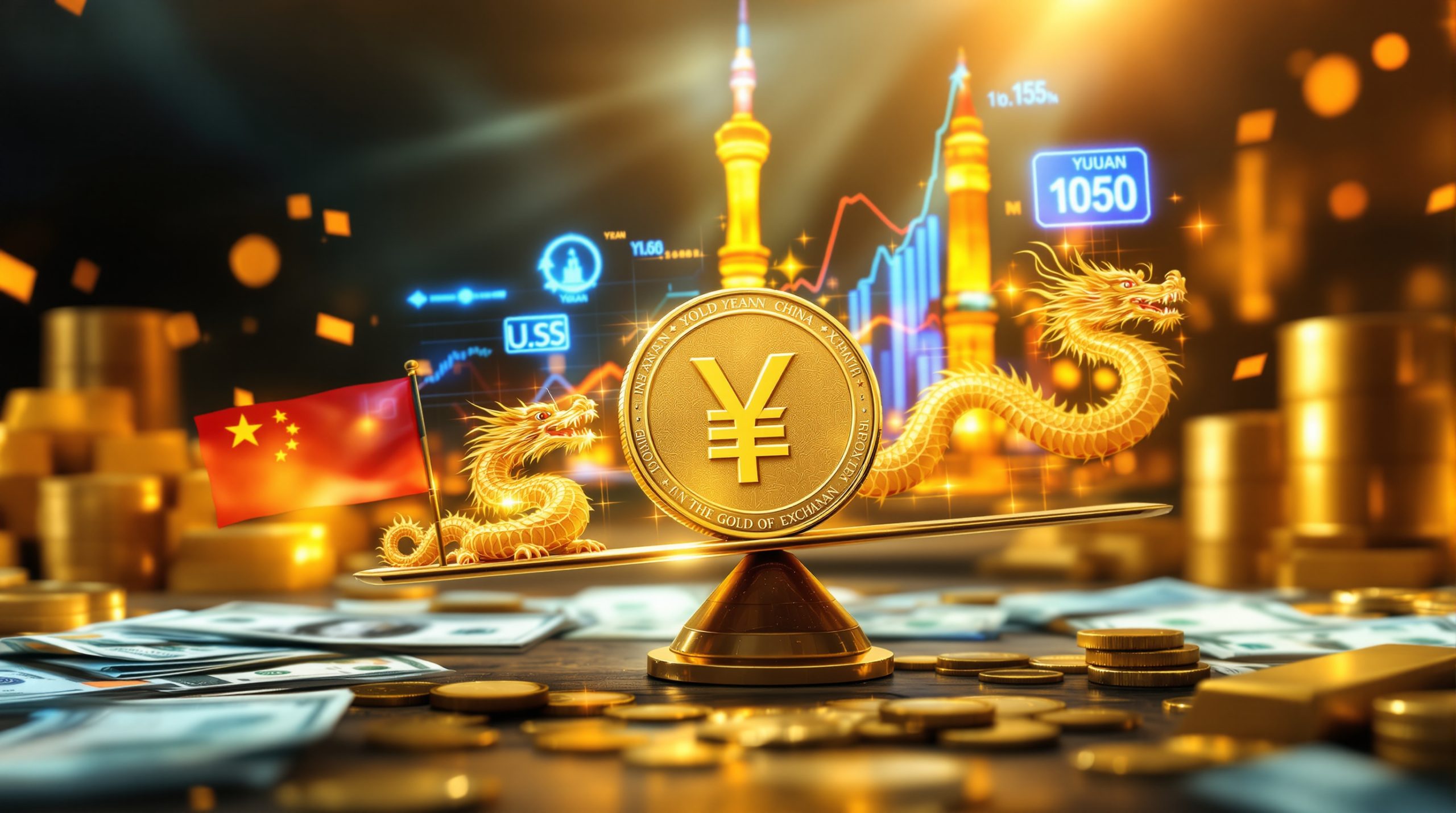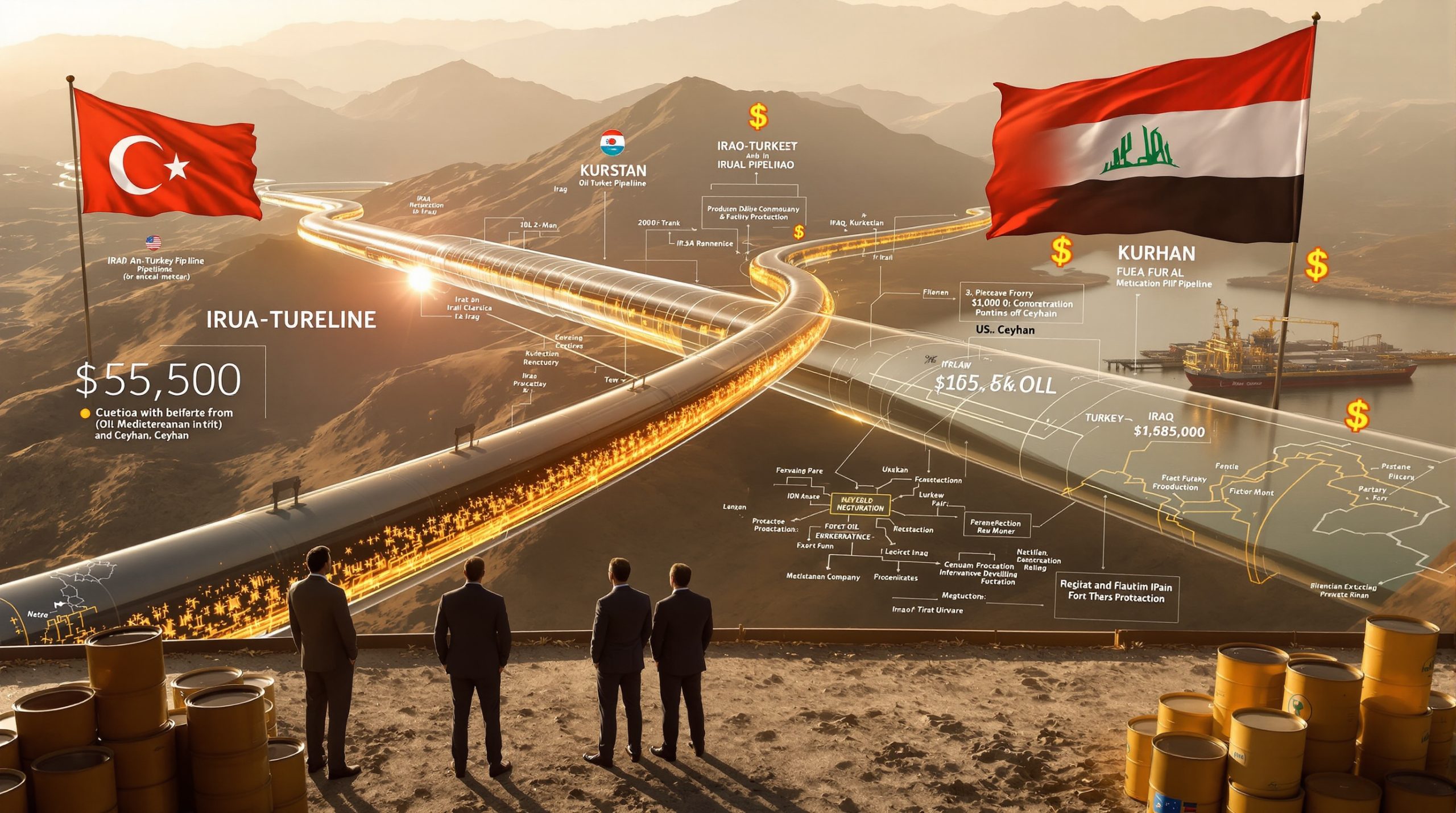What is Phosphogypsum and Why Does it Matter for Rare Earth Elements?
Phosphogypsum (PG) represents a significant untapped resource in the rare earth elements (REEs) supply chain. This calcium sulfate byproduct accumulates during phosphoric acid production when phosphate rock is treated with sulfuric acid. For decades, phosphogypsum has been viewed primarily as industrial waste, with billions of tons stockpiled globally in massive "stacks" near phosphoric acid plants.
What makes phosphogypsum particularly valuable is its consistent concentration of rare earth elements that migrate from the original phosphate rock during processing. These elements—critical for technologies ranging from electric vehicles to defense systems—become concentrated in the waste stream rather than in the primary phosphoric acid product.
The strategic importance of this resource cannot be overstated:
- Global phosphogypsum stacks contain an estimated 600,000-700,000 tonnes of rare earth oxides
- Recovery from existing waste eliminates the need for new mining operations
- Processing costs can be significantly lower than conventional rare earth mining
- Extraction creates a circular economy solution for what was previously considered waste
How Do Rare Earth Elements End Up in Phosphogypsum?
During phosphoric acid production, phosphate rock undergoes a chemical transformation when treated with sulfuric acid. This process, known as the "wet process," follows this simplified reaction:
Ca₃(PO₄)₂ + 3H₂SO₄ + 6H₂O → 2H₃PO₄ + 3(CaSO₄·2H₂O)
The rare earth elements present in the original phosphate rock primarily follow the calcium sulfate (gypsum) pathway rather than remaining in the phosphoric acid. This chemical partitioning results in phosphogypsum containing approximately 70-85% of the rare earth content from the original phosphate rock—creating an opportunity for secondary recovery.
What Makes Phosphogypsum-Based REE Extraction Different from Traditional Mining?
Economic Advantages of Phosphogypsum Processing
Traditional rare earth mining involves extensive exploration, drilling, blasting, crushing, and grinding—all before the actual extraction process begins. In contrast, phosphogypsum-based extraction starts with material that's already mined, crushed, and chemically processed, offering several distinct advantages:
| Traditional REE Mining | Phosphogypsum REE Recovery |
|---|---|
| High exploration costs | No exploration needed (known resource) |
| Extensive permitting for new mines | Often uses existing brownfield sites |
| Energy-intensive crushing and grinding | Material already in fine particle form |
| Typical grade: 0.05-0.5% REO | Comparable grades: 0.03-0.4% REO |
| High capital intensity | Reduced capital requirements |
| Long development timeline (7-10+ years) | Faster pathway to production (3-5 years) |
The absence of mining costs represents a fundamental economic advantage, potentially reducing both capital expenditure and operating costs by 30-50% compared to conventional rare earth projects.
Environmental Considerations and Benefits
Beyond economics, phosphogypsum-based rare earth recovery offers significant environmental advantages:
- Remediation of existing waste stacks that can pose environmental risks
- Reduction in the need for new mining operations and associated land disturbance
- Potential for reduced water consumption compared to conventional mining
- Opportunity to recover and sell the processed gypsum for agricultural or construction applications
- Lower overall carbon footprint when compared to traditional mining operations
These environmental benefits can translate into faster permitting processes and greater social acceptance—critical factors in bringing new rare earth supplies to market.
How Are Rare Earth Elements Extracted from Phosphogypsum?
Chemical Leaching Methods: The Primary Approach
The most established method for extracting rare earths from phosphogypsum involves acid leaching. This process dissolves the rare earth elements from the phosphogypsum matrix, allowing for their subsequent recovery from solution.
Several acids have proven effective:
-
Sulfuric acid leaching: Typically using concentrations of 10-15% at temperatures of 30-40°C for 6-8 hours. This method can achieve leaching efficiencies of 60-80% for light rare earths.
-
Hydrochloric acid leaching: Often more effective than sulfuric acid, with some studies showing extraction efficiencies up to 95% for neodymium and 86% for dysprosium at concentrations of 2.5M and temperatures around 45°C.
-
Nitric acid leaching: While less commonly used due to cost considerations, nitric acid can achieve high extraction rates, particularly for heavy rare earths.
The leaching process typically follows this sequence:
- Phosphogypsum slurry preparation (typically 20-30% solids)
- Acid addition and controlled reaction conditions (temperature, time, agitation)
- Solid-liquid separation to recover the pregnant leach solution
- Impurity removal from the leach solution
- Rare earth precipitation or ion exchange recovery
- Final purification steps to produce mixed rare earth carbonate or individual oxides
Innovative Approaches: Enhancing Recovery Efficiency
Recent technological innovations have improved the efficiency and economics of phosphogypsum rare earth recovery:
Continuous Ion Exchange Systems
Advanced continuous ion exchange (CIX) systems represent a significant improvement over batch processing. These systems:
- Reduce volumetric flow by concentrating rare earth elements from large solution volumes
- Lower reagent consumption by 20-40%
- Decrease equipment footprint and capital costs
- Enable selective recovery of different rare earth fractions
- Operate continuously, improving operational efficiency
These continuous systems can achieve remarkable volumetric reductions, transforming flows of 340 cubic meters per hour down to just 4-5 cubic meters per hour—a reduction of approximately 68-85 times the original volume. This dramatic decrease in volumetric flow means downstream separation circuits can be significantly smaller, reducing both capital expenditure and operating costs.
Bioleaching Alternatives
Emerging bioleaching approaches offer potentially more environmentally friendly extraction methods:
- Microorganisms like Gluconobacter oxydans can achieve leaching efficiencies of 7-25%
- Fungal filtrates from Aspergillus niger produce organic acids that dissolve rare earths
- Lower energy requirements and reduced chemical consumption
- Potential for selective recovery of specific rare earth elements
While still less efficient than chemical leaching, these biological approaches continue to advance and may offer complementary recovery pathways in the future.
What Challenges Must Be Overcome in Phosphogypsum REE Recovery?
Technical Hurdles in Processing
Despite its advantages, extracting rare earth elements from phosphogypsum presents several technical challenges:
-
Low concentration of target elements: With REE concentrations typically below 0.5%, large volumes must be processed to recover meaningful quantities.
-
Complex impurity profiles: Phosphogypsum contains numerous elements that can interfere with extraction and purification, including aluminum, iron, thorium, and uranium.
-
Variability between sources: The composition of phosphogypsum varies significantly depending on the original phosphate rock source, requiring customized processing approaches including adjustments to acid strength and filtration rates.
-
Scaling challenges: Moving from laboratory or pilot scale to commercial operations presents engineering challenges in maintaining extraction efficiency and managing waste streams.
-
Separation complexity: Once extracted, separating individual rare earth elements requires sophisticated techniques like solvent extraction or ion exchange chromatography.
Regulatory and Environmental Considerations
Phosphogypsum stacks are subject to regulatory oversight in most jurisdictions due to:
-
Potential radioactivity: Depending on the source phosphate rock, phosphogypsum may contain elevated levels of uranium and thorium decay products.
-
Water management concerns: Stacks can contain acidic process water that requires careful management.
-
Long-term stability requirements: Regulatory frameworks often mandate specific approaches to stack management and closure.
These regulatory considerations must be addressed in any phosphogypsum processing operation, though projects that include stack remediation as part of their business model may find regulatory support. Importantly, not all phosphogypsum sources have elevated radioactivity levels—some deposits have only background levels of radionuclides, simplifying permitting and export requirements.
How Does Phosphogypsum Processing Fit into the Global Rare Earth Supply Chain?
Strategic Importance for Western Supply Chains
With China controlling approximately 85-90% of global rare earth processing, phosphogypsum-based rare earth recovery represents a strategic opportunity for Western nations to develop independent supply chains. Key advantages include:
-
Geographic distribution: Major phosphogypsum stacks exist in the United States, Brazil, Morocco, South Africa, and across Europe—providing diversification away from Chinese supply dominance.
-
Speed to market: The ability to bypass mining development timelines means phosphogypsum projects can potentially reach production in 3-5 years versus 7-10+ for conventional mines.
-
Defense applications: Critical heavy rare earths like dysprosium and terbium, essential for defense technologies, are present in phosphogypsum and increasingly subject to supply restrictions.
-
Complementary to other sources: Phosphogypsum recovery can supplement traditional mining operations, creating a more resilient supply network.
Economic Viability and Market Positioning
The economic viability of phosphogypsum-based rare earth recovery depends on several factors:
-
Basket composition: The specific mix of rare earth elements in the phosphogypsum determines its value, with higher concentrations of magnet rare earths (Nd, Pr, Dy, Tb) significantly improving economics.
-
Processing costs: Lower capital and operating costs compared to conventional mining can enable profitable operation even at moderate rare earth prices.
-
Byproduct revenue streams: The ability to sell processed gypsum for agricultural or construction applications can provide additional revenue.
-
Strategic pricing premiums: Western buyers increasingly willing to pay premiums for non-Chinese rare earth supplies to secure supply chain resilience.
-
Government support: Strategic minerals reserve initiatives in the US, EU, and other regions may provide financial support, offtake agreements, or other incentives.
Market trends indicate a growing price bifurcation between Chinese and Western rare earth markets. For example, dysprosium and terbium have traded in Europe at approximately twice the Chinese price in recent periods. Similarly, neodymium and praseodymium prices have shown significant differences between markets, with Japanese buyers paying approximately $82/kg while Chinese prices hovered around $60/kg for the same materials—reflecting the premium Western markets will pay for supply security.
Which Companies Are Leading Phosphogypsum REE Recovery?
Commercial Projects in Development
Several companies have advanced phosphogypsum-based rare earth recovery projects to various stages of development:
Rainbow Rare Earths (Phalaborwa Project, South Africa)
This project targets the recovery of rare earths from phosphogypsum stacks near Phalaborwa, South Africa. Key features include:
- Approximately 35 million tonnes of phosphogypsum containing 0.36% rare earth oxides
- Focus on producing separated neodymium, praseodymium, and heavy rare earth concentrates
- Continuous ion exchange technology to reduce volumetric flow and processing costs
- Projected 16-year operational life with production targeted for 2027-2028
- Strategic partnership with the US International Development Finance Corporation
The project economics indicate an EBITDA margin over 75% and an internal rate of return between 45-50%, with capital expenditure estimated at approximately $300 million from start to finish.
Rainbow Rare Earths/Mosaic JV (Uberaba Project, Brazil)
A 50/50 joint venture between Rainbow Rare Earths and global fertilizer producer Mosaic to recover rare earths from phosphogypsum at Mosaic's Uberaba operations:
- Access to both historic and actively produced phosphogypsum
- Leverages technology developed at the Phalaborwa project
- Potential for long-term production from ongoing phosphoric acid operations
- Initial economic assessment underway with results expected in 2025
This partnership with Mosaic, a $15 billion fertilizer business, provides access to an active phosphoric acid operation that continues to produce new phosphogypsum daily, offering potentially unlimited project life.
Other Emerging Projects
Additional projects in various stages of development include:
- Initiatives in Florida's extensive phosphogypsum stacks
- European projects examining phosphogypsum resources
- Exploration of Saudi Arabian and Moroccan phosphogypsum resources
Research Institutions Advancing the Technology
Academic and government research institutions continue to advance phosphogypsum rare earth recovery technology:
- The Critical Materials Institute (USA) has conducted extensive research on optimized leaching and recovery techniques
- European research consortiums exploring phosphogypsum valorization for critical minerals
- University partnerships with industry to develop next-generation bioleaching approaches
- National laboratories developing advanced separation technologies for rare earth purification
What Does the Future Hold for Phosphogypsum-Based REE Recovery?
Technological Trends and Innovations
The future of phosphogypsum-based rare earth recovery will likely be shaped by several technological trends:
-
Process integration: Combining rare earth recovery with phosphoric acid production in new facilities to maximize efficiency and minimize waste generation.
-
Advanced separation technologies: Development of more selective and efficient methods for separating individual rare earth elements, reducing processing costs.
-
Automation and digitalization: Implementation of advanced process control and monitoring systems to optimize extraction efficiency and reduce operating costs.
-
Comprehensive resource recovery: Extracting multiple value streams from phosphogypsum beyond rare earths, including other critical minerals and energy security.
-
Closed-loop water systems: Minimizing water consumption and environmental impact through advanced water recycling and treatment technologies.
Market Outlook and Strategic Implications
The market outlook for phosphogypsum-based rare earth production appears promising, driven by several factors:
-
Growing demand for magnet rare earths: Projected demand growth of 7-10% annually for neodymium, praseodymium, dysprosium, and terbium, driven by electric vehicles, wind turbines, and robotics.
-
Supply chain security concerns: Increasing government and industry focus on developing non-Chinese rare earth supplies, potentially including price floors or strategic stockpiling.
-
ESG considerations: Growing investor and consumer preference for materials with lower environmental footprints and positive social impacts.
-
Technology metal demand growth: Beyond traditional applications, emerging technologies like humanoid robotics could drive significant additional demand for permanent magnets and their constituent rare earths.
-
Defense applications: Continued growth in precision-guided munitions, drones, and other defense technologies requiring rare earth magnets.
Recent market developments include the establishment of floor pricing for critical rare earths. For example, MP Materials and the U.S. Department of Defense set a floor price of $110/kg for neodymium and praseodymium, which represent approximately 75% of the revenue in typical rare earth baskets. This benchmark has significant implications for other rare earth projects, providing price stability that supports financing and development decisions.
How Can Phosphogypsum Processing Contribute to a Circular Economy?
Waste-to-Resource Transformation
Phosphogypsum processing exemplifies circular economy principles by transforming what was previously considered waste into valuable resources:
-
Resource efficiency: Extracting additional value from materials that have already been mined and processed.
-
Waste reduction: Decreasing the volume of phosphogypsum requiring long-term management.
-
Land reclamation: Potential to completely remediate phosphogypsum stack sites after processing.
-
Multiple value streams: Recovering rare earths while also producing gypsum for beneficial use in agriculture or construction.
-
Reduced environmental liability: Converting environmental liabilities into economic assets while reducing long-term management costs.
Environmental and Social Benefits
Beyond the direct economic benefits, phosphogypsum-based rare earth recovery offers broader environmental and social advantages:
-
Reduced mining impact: Decreasing the need for new rare earth mines and their associated environmental footprint.
-
Water quality improvement: Potential to improve groundwater quality near phosphogypsum stacks through proper processing and remediation.
-
Job creation in existing industrial areas: Creating new employment opportunities in regions with existing phosphate processing infrastructure.
-
Technology development: Advancing separation and recovery technologies that may have applications in other waste valorization contexts.
-
Supply chain resilience: Contributing to more diverse and resilient critical mineral supply chains, reducing vulnerability to disruptions.
Many phosphogypsum recovery projects include comprehensive site rehabilitation plans. For example, processed phosphogypsum can be redeposited onto lined stack sites, protecting groundwater. In some cases, companies plan to sell approximately 400,000 tons of processed phosphogypsum annually into agricultural markets, gradually reducing stack volumes until sites are completely rehabilitated over 40+ years.
What Questions Should Investors Ask About Phosphogypsum REE Projects?
Technical and Economic Considerations
Investors evaluating phosphogypsum-based rare earth projects should consider several key factors:
-
Recovery rates: What percentage of the contained rare earths can be economically recovered?
-
Basket composition: What is the distribution of rare earth elements, particularly high-value magnet materials versus lower-value elements?
-
Processing approach: What technologies are being employed for leaching, separation, and purification?
-
Capital intensity: How does the capital expenditure compare to conventional rare earth projects on a per-kilogram production basis?
-
Operating costs: What are the projected operating costs, and how do they compare to industry benchmarks?
-
Byproduct revenue: What additional revenue streams exist beyond rare earth elements?
-
Scale and scalability: What is the initial production scale, and what potential exists for expansion?
Regulatory and Strategic Factors
Beyond technical considerations, several strategic and regulatory factors warrant attention:
-
Permitting status: What permits are required, and what is their current status?
-
Offtake agreements: Are there existing or potential agreements with end-users or processors?
-
Government support: Is the project eligible for government funding, loan guarantees, or other support mechanisms?
-
Intellectual property: What proprietary technologies or processes does the company control?
-
Team experience: Does the management team have relevant experience in rare earth processing or phosphate industry operations?
-
Timeline to production: What is the realistic timeline from current status to commercial production?
-
Environmental liabilities: How are residual materials managed, and what long-term obligations exist?
Financing structures for these projects typically target a mix of debt and equity. For example, some projects aim for approximately 2/3 debt ($200 million) and 1/3 equity ($100 million), with government development finance institutions potentially contributing significant portions of the equity component.
Frequently Asked Questions About Phosphogypsum REE Recovery
How do rare earth concentrations in phosphogypsum compare to conventional mines?
Rare earth concentrations in phosphogypsum typically range from 0.03% to 0.4% total rare earth oxides (TREO), which is comparable to many conventional rare earth deposits. While some primary rare earth deposits contain higher grades (1-10% TREO), many economically viable projects operate with grades of 0.1-0.5% TREO. The economic advantage of phosphogypsum lies not in higher concentrations but in the elimination of mining costs and the material being already in a chemically processed state.
Are there radioactivity concerns with phosphogypsum processing?
The radioactivity of phosphogypsum varies significantly depending on the source phosphate rock. Some phosphogypsum contains elevated levels of naturally occurring radioactive materials (NORM), primarily from uranium and thorium decay products. However, many phosphogypsum sources have only background levels of radioactivity, making them straightforward to process and export. Projects must conduct thorough radiological characterization and implement appropriate management protocols where needed.
How does phosphogypsum processing impact water resources?
Water management is a critical consideration in phosphogypsum processing. Leading projects implement closed-loop water systems that minimize consumption and prevent discharge to the environment. Process water is typically recycled within the operation, and any discharge is treated to meet regulatory standards. Some projects may actually improve local water quality by remediating existing stack sites that could otherwise pose risks to groundwater.
What is the potential market size for rare earths from phosphogypsum?
Given the estimated 600,000-700,000 tonnes of rare earth oxides contained in global phosphogypsum stacks, and annual additions of approximately 100,000-150,000 tonnes through ongoing phosphoric acid production, phosphogypsum could potentially supply 15-20% of global rare earth demand. This represents a significant contribution to diversifying supply chains, particularly for critical heavy rare earths that are subject to greater supply constraints.
How do phosphogypsum REE projects compare to recycling as a secondary source?
While recycling remains important for long-term rare earth sustainability, phosphogypsum recovery offers several advantages in the near to medium term. The concentration of rare earths in phosphogypsum (0.03-0.4%) is typically higher than in many end-of-life products, and the material is already collected in central locations rather than dispersed across consumer markets. Additionally, phosphogypsum recovery can begin production sooner than recycling can reach meaningful scale, helping to address immediate supply chain vulnerabilities.
What role could government policy play in accelerating phosphogypsum REE recovery?
Government policies could significantly accelerate phosphogypsum rare earth recovery through several mechanisms:
- Direct investment or loan guarantees for project development
- Establishment of floor prices or offtake agreements for strategic materials
- Regulatory frameworks that recognize and incentivize the environmental benefits of stack remediation
- Research and development funding for advanced separation technologies
- Tax incentives for projects that contribute to mining industry evolution and mine reclamation advances
Recent examples include the U.S. Department of Defense's floor price agreement with MP Materials and development finance institution support for international projects. Furthermore, many countries are now recognizing the decarbonisation benefits associated with extracting rare earth elements from existing waste streams rather than opening new mines.
Searching for the Next Major Mineral Discovery?
Discover how significant ASX mineral finds like phosphogypsum-based rare earth projects can generate substantial returns by exploring Discovery Alert's dedicated discoveries page. Their proprietary Discovery IQ model instantly transforms complex mineral data into actionable investment insights, positioning you ahead of the market.




